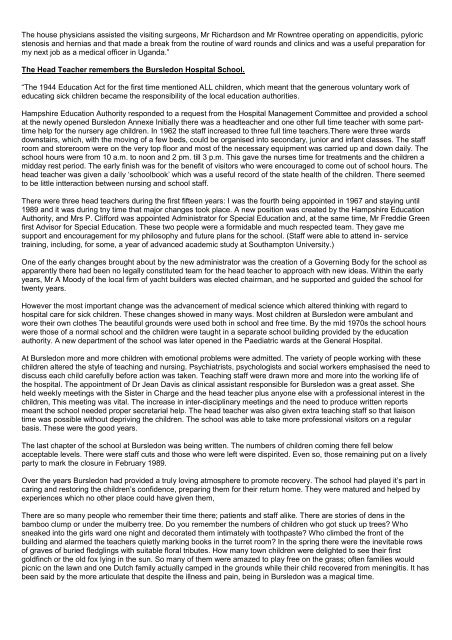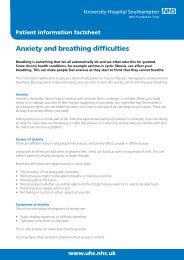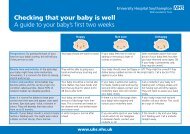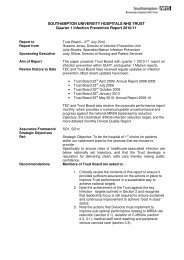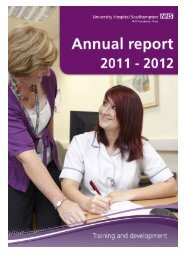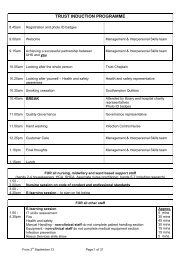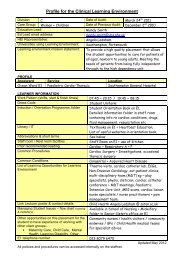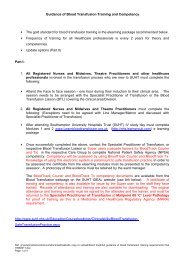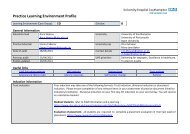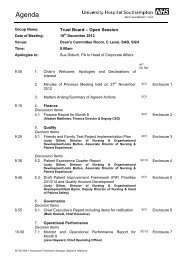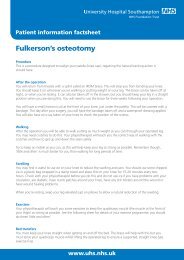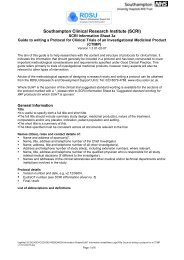ninety years of service - University Hospital Southampton NHS ...
ninety years of service - University Hospital Southampton NHS ...
ninety years of service - University Hospital Southampton NHS ...
- No tags were found...
You also want an ePaper? Increase the reach of your titles
YUMPU automatically turns print PDFs into web optimized ePapers that Google loves.
The house physicians assisted the visiting surgeons, Mr Richardson and Mr Rowntree operating on appendicitis, pyloricstenosis and hernias and that made a break from the routine <strong>of</strong> ward rounds and clinics and was a useful preparation formy next job as a medical <strong>of</strong>ficer in Uganda.”The Head Teacher remembers the Bursledon <strong>Hospital</strong> School.“The 1944 Education Act for the first time mentioned ALL children, which meant that the generous voluntary work <strong>of</strong>educating sick children became the responsibility <strong>of</strong> the local education authorities.Hampshire Education Authority responded to a request from the <strong>Hospital</strong> Management Committee and provided a schoolat the newly opened Bursledon Annexe Initially there was a headteacher and one other full time teacher with some parttimehelp for the nursery age children. In 1962 the staff increased to three full time teachers.There were three wardsdownstairs, which, with the moving <strong>of</strong> a few beds, could be organised into secondary, junior and infant classes. The staffroom and storeroom were on the very top floor and most <strong>of</strong> the necessary equipment was carried up and down daily. Theschool hours were from 10 a.m. to noon and 2 pm. till 3 p.m. This gave the nurses time for treatments and the children amidday rest period. The early finish was for the benefit <strong>of</strong> visitors who were encouraged to come out <strong>of</strong> school hours. Thehead teacher was given a daily ‘schoolbook’ which was a useful record <strong>of</strong> the state health <strong>of</strong> the children. There seemedto be little intteraction between nursing and school staff.There were three head teachers during the first fifteen <strong>years</strong>: I was the fourth being appointed in 1967 and staying until1989 and it was during tny time that major changes took place. A new position was created by the Hampshire EducationAuthority, and Mrs P. Clifford was appointed Administrator for Special Education and, at the same time, Mr Freddie Greenfirst Advisor for Special Education. These two people were a formidable and much respected team. They gave mesupport and encouragement for my philosophy and future plans for the school. (Staff were able to attend in- <strong>service</strong>training, including, for some, a year <strong>of</strong> advanced academic study at <strong>Southampton</strong> <strong>University</strong>.)One <strong>of</strong> the early changes brought about by the new administrator was the creation <strong>of</strong> a Governing Body for the school asapparently there had been no legally constituted team for the head teacher to approach with new ideas. Within the early<strong>years</strong>, Mr A Moody <strong>of</strong> the local firm <strong>of</strong> yacht builders was elected chairman, and he supported and guided the school fortwenty <strong>years</strong>.However the most important change was the advancement <strong>of</strong> medical science which altered thinking with regard tohospital care for sick children. These changes showed in many ways. Most children at Bursledon were ambulant andwore their own clothes The beautiful grounds were used both in school and free time. By the mid 1970s the school hourswere those <strong>of</strong> a normal school and the children were taught in a separate school building provided by the educationauthority. A new department <strong>of</strong> the school was later opened in the Paediatric wards at the General <strong>Hospital</strong>.At Bursledon more and more children with emotional problems were admitted. The variety <strong>of</strong> people working with thesechildren altered the style <strong>of</strong> teaching and nursing. Psychiatrists, psychologists and social workers emphasised the need todiscuss each child carefully before action was taken. Teaching staff were drawn more and more into the working life <strong>of</strong>the hospital. The appointment <strong>of</strong> Dr Jean Davis as clinical assistant responsible for Bursledon was a great asset. Sheheld weekly meetings with the Sister in Charge and the head teacher plus anyone else with a pr<strong>of</strong>essional interest in thechildren, This meeting was vital. The increase in inter-disciplinary meetings and the need to produce written reportsmeant the school needed proper secretarial help. The head teacher was also given extra teaching staff so that liaisontime was possible without depriving the children. The school was able to take more pr<strong>of</strong>essional visitors on a regularbasis. These were the good <strong>years</strong>.The last chapter <strong>of</strong> the school at Bursledon was being written. The numbers <strong>of</strong> children coming there fell belowacceptable levels. There were staff cuts and those who were left were dispirited. Even so, those remaining put on a livelyparty to mark the closure in February 1989.Over the <strong>years</strong> Bursledon had provided a truly loving atmosphere to promote recovery. The school had played it’s part incaring and restoring the children’s confidence, preparing them for their return home. They were matured and helped byexperiences which no other place could have given them,There are so many people who remember their time there; patients and staff alike. There are stories <strong>of</strong> dens in thebamboo clump or under the mulberry tree. Do you remember the numbers <strong>of</strong> children who got stuck up trees? Whosneaked into the girls ward one night and decorated them intimately with toothpaste? Who climbed the front <strong>of</strong> thebuilding and alarmed the teachers quietly marking books in the turret room? In the spring there were the inevitable rows<strong>of</strong> graves <strong>of</strong> buried fledglings with suitable floral tributes. How many town children were delighted to see their firstgoldfinch or the old fox lying in the sun. So many <strong>of</strong> them were amazed to play free on the grass; <strong>of</strong>ten families wouldpicnic on the lawn and one Dutch family actually camped in the grounds while their child recovered from meningitis. It hasbeen said by the more articulate that despite the illness and pain, being in Bursledon was a magical time.


